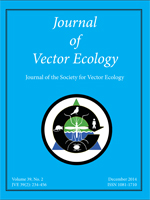The behavioral responses of colony populations of Aedes aegypti, Aedes albopictus, Culex quinquefasciatus, and Anopheles minimus to four essential oils (citronella, hairy basil, catnip, and vetiver), two standard repellents (DEET and picaridin), and two synthetic pyrethroids (deltamethrin and permethrin) were conducted in the laboratory using an excito-repellency test system. Results revealed that Cx. quinquefasciatus and An. minimus exhibited much stronger behavioral responses to all test compounds (65–98% escape for contact, 21.4–94.4% escape for non-contact) compared to Ae. aegypti (3.7–72.2% escape (contact), 0–31.7% (non-contact)) and Ae. albopictus (3.5–94.4% escape (contact), 11.2–63.7% (non-contact)). In brief, essential oil from vetiver elicited the greatest irritant responses in Cx. quinquefasciatus (96.6%) and An. minimus (96.5%) compared to the other compounds tested. The synthetic pyrethroids caused a stronger contact irritant response (65–97.8% escape) than non-contact repellents (0-50.8% escape for non-contact) across all four mosquito species. Picaridin had the least effect on all mosquito species. Findings from the current study continue to support the screening of essential oils from various plant sources for protective properties against field mosquitoes.
How to translate text using browser tools
1 December 2014
Behavioral Responses of Aedes aegypti, Aedes albopictus, Culex quinquefasciatus, and Anopheles minimus Against Various Synthetic and Natural Repellent Compounds
Sunaiyana Sathantriphop,
Sabrina A. White,
Nicole L. Achee,
Unchalee Sanguanpong,
Theeraphap Chareonviriyaphap
ACCESS THE FULL ARTICLE
It is not available for individual sale.
This article is only available to subscribers.
It is not available for individual sale.
It is not available for individual sale.

Journal of Vector Ecology
Vol. 39 • No. 2
December 2014
Vol. 39 • No. 2
December 2014
Aedes aegypti
Aedes albopictus
Anopheles minimus
Contact irritant
Culex quinquefasciatus
excito-repellency
non-contact repellent




